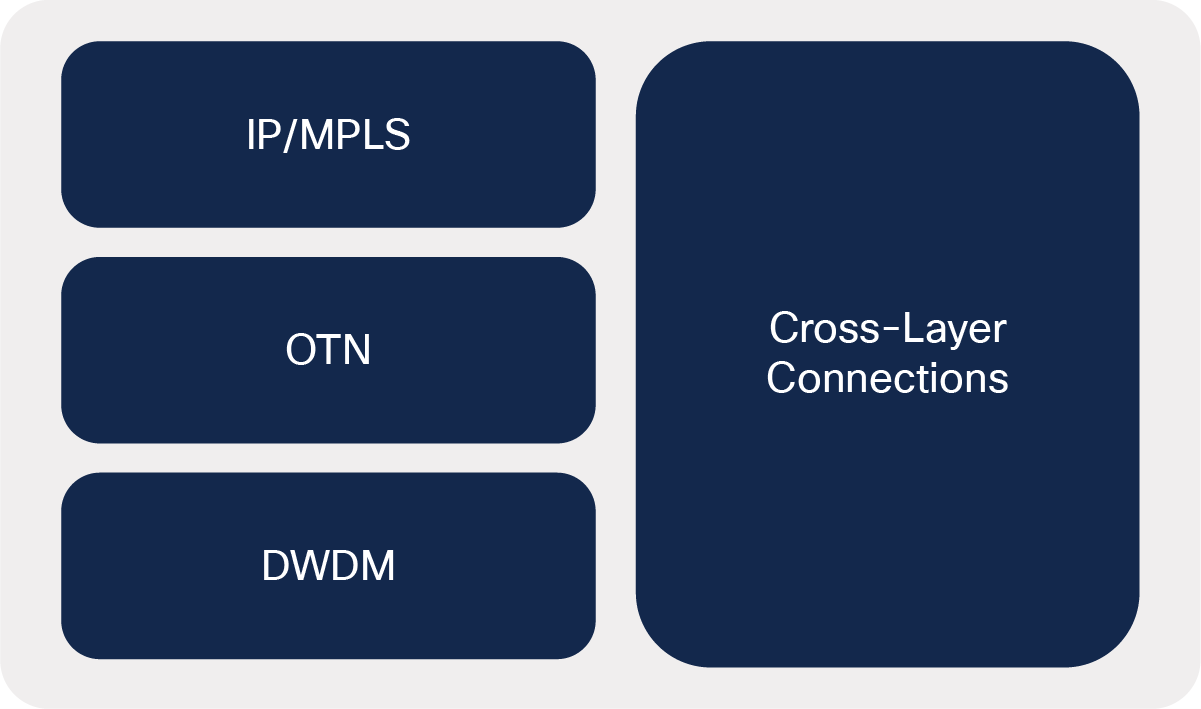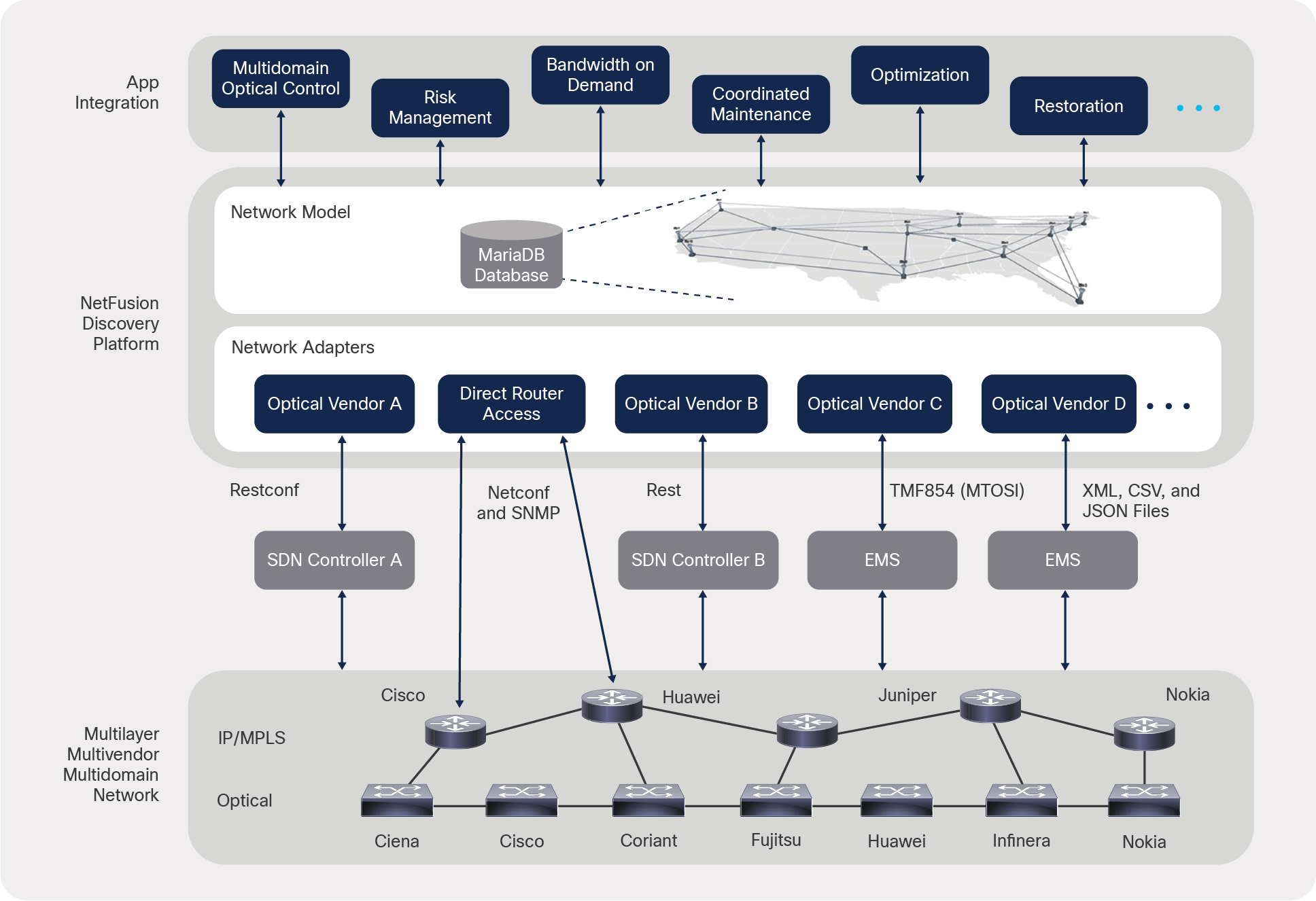Crosswork Hierarchical Controller: Network Discovery and Visibility Capabilities White Paper
Available Languages
Bias-Free Language
The documentation set for this product strives to use bias-free language. For the purposes of this documentation set, bias-free is defined as language that does not imply discrimination based on age, disability, gender, racial identity, ethnic identity, sexual orientation, socioeconomic status, and intersectionality. Exceptions may be present in the documentation due to language that is hardcoded in the user interfaces of the product software, language used based on RFP documentation, or language that is used by a referenced third-party product. Learn more about how Cisco is using Inclusive Language.
This white paper describes Cisco Crosswork® Hierarchical Controller’s Intelligence and Automation App Platform, which enables multivendor discovery of the optical layer, IP/MPLS layer, and cross-connections between the two layers. The accompanying Hierarchical Controller’s Explorer UI enables you to visualize and explore this multilayer network model in near real time, showing optically aware IP/MPLS routing and, conversely, IP/MPLS-informed optical paths.
Cisco Crosswork Hierarchical Controller’s Discovery Capabilities
Cisco Crosswork Hierarchical Controller’s Discovery features enable multivendor discovery of the optical layer, IP/MPLS layer, and the cross-connections between the two layers. The accompanying Hierarchical Controller’s Explorer UI enables you to visualize and explore this multilayer network model in near real time, showing optically aware IP/MPLS routing and, conversely, IP/MPLS-informed optical paths.
Based on centralized open-source software tools, Hierarchical Controller’s Discovery feature connects to both legacy EMS and NMS servers, as well as to newly evolving SDN controllers. All emerging standards, such as IETF, ONF, and OIF, are supported. This flexibility enables you to start with simple network discovery today and build solutions that can expand in the future without replacing the software.
Hierarchical Controller’s Discovery features enable vendor-agnostic apps with a multilayer, multivendor platform supporting carrier-grade robustness. Hierarchical Controller Discovery features enable you to cost-efficiently optimize multilayer networks across interoptical domains. Sample apps give you the ability to provision bandwidth on demand, restore links, and identify shared optical risks, all across both the IP/MPLS layer and optical layer, and all across multiple vendors.
By communicating with the EMS/NMS management systems and SDN controllers, Hierarchical Controller Discovery uses a read-only process to automatically learn and continuously update both the optical topology and the IP/MPLS topology. Hierarchical Controller Discovery also continuously receives route information and traffic updates for each layer. Attributes such as IP traffic, LSPs (MPLS tunnels), OTN connections, and DWDM light paths are incorporated and continuously updated in the internal database. To complete this picture, Hierarchical Controller Discovery collects the cross-layer mapping of connections so that you have knowledge of how each layer interacts with the other. In this manner, Hierarchical Controller Discovery is always aware of L0-L3 failures, L0-L3 topology changes, and L3 traffic fluctuations. The frequency of the network model updates is dependent on your configuration.

Crosswork Hierarchical Controller’s design principles are simple. (1) Provide a dynamic solution you can use today, while allowing you to build for tomorrow. (2) Leverage expertise where possible. (3) Allow for flexible app integration.
Dynamic solutions
The Hierarchical Controller solution works with existing equipment so there are no changes needed to network elements. You can continue to grow and modify this existing solution as needed. For instance, Hierarchical Controller supports the next step of using SDN controller REST APIs. It also supports enhancing these solutions by isolating apps from changes to the APIs. This dynamic solution facilitates early deployment of apps using existing equipment while allowing you to later add new SDN controllers for improved network performance and simplified operations. This evolution does not affect existing apps and ensures that you can build future solutions without service disruption. As SDN controllers are installed, more apps are enabled and existing apps evolve to operate in real time.
Leveraged expertise
Using internal network adapters enables Hierarchical Controller to leverage the trusted expertise that exists in the SDN controllers and management systems for each layer and vendor. Rather than inventing yet another solution, Hierarchical Controller connects with components that have been proven reliable and are already in your network.
● Optical layer controllers and management systems identify which connections are feasible in each specific vendor’s network.
● IP/MPLS layer controllers and management systems collect traffic statistics across complex IP/MPLS networks.
● IP/MPLS layer simulators predict routing behavior while the network is changing. For example, these simulators know how to perform what-if analysis on every failure in the network and how to optimize accordingly.
Flexible app integration
Hierarchical Controller is easily extendible by adding and modifying apps and by adding network adapters for other vendors or planning tools. This means you can use whatever trusted software best suits your environment. You can grow the Hierarchical Controller solution to meet your needs, rather than being forced into a predefined solution. Note that future plans include extension of support to include third-party apps.
Hierarchical Controller’s Discovery architecture
Figure 1 shows the Hierarchical Controller Discovery architecture that manages network discovery, the abstraction of the discovered network into a model available through a UI, and access to apps. This infrastructure, which is based on open-source software, accesses devices and apps from multiple vendors.
| Access |
Method |
| SDN controllers |
REST and RESTCONF |
| EMS and NMS servers |
● TMF814 (MTNM) and TMF854 (MTOSI) APIs
● CSV, XML, and JSON files exported to file servers
|
| Directly accessing network elements |
● NETCONF for router topology
● SNMP for traffic statistics
● TL1 for direct access to optical network elements
|
● To collect information, Hierarchical Controller uses network adapters that adapt to different APIs in order to learn about L0-L3 networks. Each Hierarchical Controller network adapter supports a different API that translates the information into an abstracted network model and updates the database with topology and traffic statistics.
The manual network adapter is different from the other network adapters in that it is typically used internally by our support and development teams to manually insert, update, or delete network elements from the abstract network model. While this network adapter is usually used in proof-of-concept labs, it can also be used to complete the abstract model when information is not available in the network.
● Hierarchical Controller creates and stores an abstract model of the network in MariaDB, which is an open-source, relational database that provides an SQL interface for accessing data. MariaDB provides persistency, backup, clustering, high availability, and security. Since MariaDB releases security bulletins as needed, we are able to stay at the forefront of any emerging security concerns.
● The network model allows access to apps. If an app needs to listen to specific changes in the network, it registers with a notifications bus in the abstract model. An app can ask to be notified of creation, updates, or deletion of network elements.
Additionally, this network model information can be exported to external systems in support of customer use cases.

Hierarchical Controller Discovery architecture with example apps and vendors
When notifications are supported, Hierarchical Controller network adapters use these notifications to learn about topology and state changes as quickly as they are made available. When network components and APIs do not support unsolicited notifications, Hierarchical Controller actively polls the network component to learn these updates. The polling period is configurable and can be as low as tens of seconds for SDN controllers or can be minutes and dozens of minutes when talking directly with the network elements.
An app can send an abstract request for creating, updating, or deleting elements in the network. The network adapter that is in charge of the relevant part of the network listens to the request, translates it from an abstracted request to the specific API call that accesses the network, and then executes the request.
For example, a link provisioning app can initiate three link creation requests: one for an IP network, one for optical network A, and one for optical network B. The Hierarchical Controller network adapter that controls the routers would provision the new IP link, and the network adapters for the optical nodes would each create the relevant optical link.
Apps can use an external planning tool, such as Cisco® WAE, to run network simulations and what-if failure analyses. The planning tool is accessed through an adaptation layer that provides an abstraction of the specific interface. This adaptation layer supports simple functions to run the planning tool, as well as a bidirectional conversion between the abstract network model and the planning tool’s network model format. In this manner, the app does not need to be aware of the planning tool being used.
Note that to use these planning tools, you must identify the tool of choice and own a license to run it. Contact your Cisco support representative for more information.
Cisco Crosswork Hierarchical Controller is the most powerful, most flexible SDN-ready platform available today. This industry-leading multilayer, multivendor solution enables you to understand L0-L3 networks without replacing costly equipment. You can use the near real-time network map to stay aware of the network state and traffic, while gradually building more control through adding apps.
Accelerate your journey to next-generation networking with visibility, insights, and action
To learn more on how Cisco Crosswork Hierarchical Controller turns your complex multilayer and multivendor infrastructure into a unified, easily controlled network, please visit www.cisco.com/go/crosswork.
To schedule a demonstration of Crosswork Hierarchical Controller, contact your Cisco sales representative.